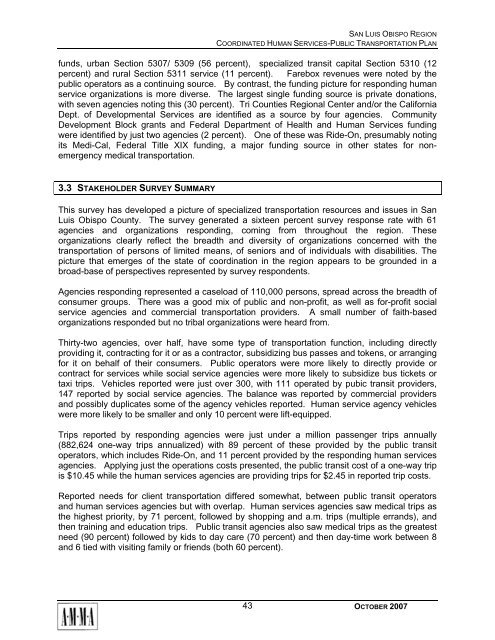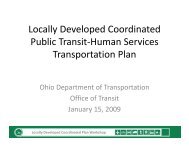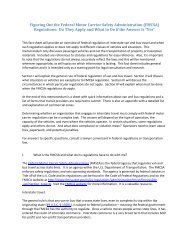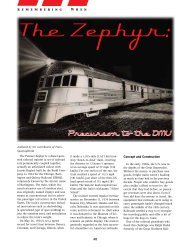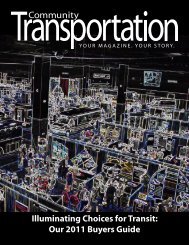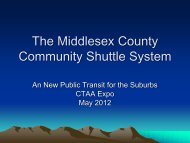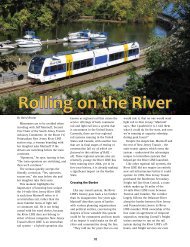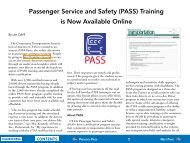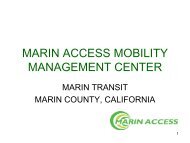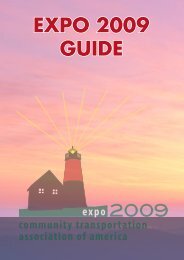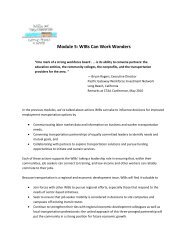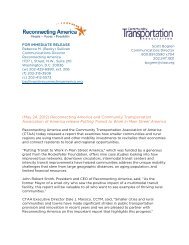San Luis Obispo - Caltrans - State of California
San Luis Obispo - Caltrans - State of California
San Luis Obispo - Caltrans - State of California
You also want an ePaper? Increase the reach of your titles
YUMPU automatically turns print PDFs into web optimized ePapers that Google loves.
SAN LUIS OBISPO REGION<br />
COORDINATED HUMAN SERVICES-PUBLIC TRANSPORTATION PLAN<br />
funds, urban Section 5307/ 5309 (56 percent), specialized transit capital Section 5310 (12<br />
percent) and rural Section 5311 service (11 percent). Farebox revenues were noted by the<br />
public operators as a continuing source. By contrast, the funding picture for responding human<br />
service organizations is more diverse. The largest single funding source is private donations,<br />
with seven agencies noting this (30 percent). Tri Counties Regional Center and/or the <strong>California</strong><br />
Dept. <strong>of</strong> Developmental Services are identified as a source by four agencies. Community<br />
Development Block grants and Federal Department <strong>of</strong> Health and Human Services funding<br />
were identified by just two agencies (2 percent). One <strong>of</strong> these was Ride-On, presumably noting<br />
its Medi-Cal, Federal Title XIX funding, a major funding source in other states for nonemergency<br />
medical transportation.<br />
3.3 STAKEHOLDER SURVEY SUMMARY<br />
This survey has developed a picture <strong>of</strong> specialized transportation resources and issues in <strong>San</strong><br />
<strong>Luis</strong> <strong>Obispo</strong> County. The survey generated a sixteen percent survey response rate with 61<br />
agencies and organizations responding, coming from throughout the region. These<br />
organizations clearly reflect the breadth and diversity <strong>of</strong> organizations concerned with the<br />
transportation <strong>of</strong> persons <strong>of</strong> limited means, <strong>of</strong> seniors and <strong>of</strong> individuals with disabilities. The<br />
picture that emerges <strong>of</strong> the state <strong>of</strong> coordination in the region appears to be grounded in a<br />
broad-base <strong>of</strong> perspectives represented by survey respondents.<br />
Agencies responding represented a caseload <strong>of</strong> 110,000 persons, spread across the breadth <strong>of</strong><br />
consumer groups. There was a good mix <strong>of</strong> public and non-pr<strong>of</strong>it, as well as for-pr<strong>of</strong>it social<br />
service agencies and commercial transportation providers. A small number <strong>of</strong> faith-based<br />
organizations responded but no tribal organizations were heard from.<br />
Thirty-two agencies, over half, have some type <strong>of</strong> transportation function, including directly<br />
providing it, contracting for it or as a contractor, subsidizing bus passes and tokens, or arranging<br />
for it on behalf <strong>of</strong> their consumers. Public operators were more likely to directly provide or<br />
contract for services while social service agencies were more likely to subsidize bus tickets or<br />
taxi trips. Vehicles reported were just over 300, with 111 operated by pubic transit providers,<br />
147 reported by social service agencies. The balance was reported by commercial providers<br />
and possibly duplicates some <strong>of</strong> the agency vehicles reported. Human service agency vehicles<br />
were more likely to be smaller and only 10 percent were lift-equipped.<br />
Trips reported by responding agencies were just under a million passenger trips annually<br />
(882,624 one-way trips annualized) with 89 percent <strong>of</strong> these provided by the public transit<br />
operators, which includes Ride-On, and 11 percent provided by the responding human services<br />
agencies. Applying just the operations costs presented, the public transit cost <strong>of</strong> a one-way trip<br />
is $10.45 while the human services agencies are providing trips for $2.45 in reported trip costs.<br />
Reported needs for client transportation differed somewhat, between public transit operators<br />
and human services agencies but with overlap. Human services agencies saw medical trips as<br />
the highest priority, by 71 percent, followed by shopping and a.m. trips (multiple errands), and<br />
then training and education trips. Public transit agencies also saw medical trips as the greatest<br />
need (90 percent) followed by kids to day care (70 percent) and then day-time work between 8<br />
and 6 tied with visiting family or friends (both 60 percent).<br />
43<br />
OCTOBER 2007


